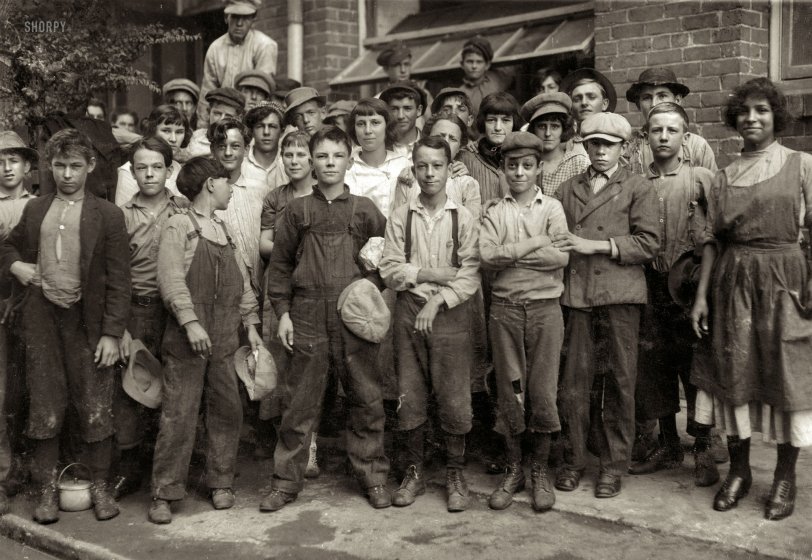


Framed or unframed, desk size to sofa size, printed by us in Arizona and Alabama since 2007. Explore now.
Shorpy is funded by you. Patreon contributors get an ad-free experience.
Learn more.

- Lofty addition
- In 1912
- Keenan Building
- Six years old
- Taken from the P.J. McArdle Roadway?
- It stood only 47 years
- Three track mind
- Incline to the right
- Reach for the sky, 1912 style
- No clean sweep
- Same Job Title, Same Face
- Sadly Lost
- Beautiful ...
- Where you get your kicks
- Aim High
- Pueblo Revival sisters
- Pueblo Neoclassicism
- Milk Man
- Regional dialect.
- Spielberg's inspiration
- Great Photo
- Loaf Story
- Do you still have the Rakes category?
- Could almost be a scene from the 1957 movie 'Hell Drivers'
- The Wages of Fear.
- Conspicuous by their absence
- Got Milk?
- All that aluminum
- No lefties
- Smoke 'em if you've got 'em
Print Emporium
Lane Mill: 1913

November 1913. New Orleans, Louisiana. "Group of workers in Lane Cotton Mill showing the youngest workers and typical of conditions in New Orleans. Violations of the law are rare." Photo by Lewis Wickes Hine. View full size.
Labor
Like just about everything else you could do, working in a cotton mill looks a lot more pleasant than working in a coal mine (goin' down, down, down...) They all look relatively happy and neatly dressed compared to some of the child labor seen here.
Lane Cotton Mill
I found a local (New Orleans) history column about the Mill. It lasted almost 100 years. Not bad.
14, and aging fast
Around 1900, my step great grandfather was a subject in his mothers divorce. the decree stated that she would be responsible for his care until he reached the age of 14. A month after his birthday, his step father ordered him from the farm, as he was deemed "to light-weight to do farm work". Eventually he joined our family and provided shelter and sometimes food to many in our family.
How young could you be?
If none of these kids were underage, what was the minimum age at that time for mill work? Those boys in front seem 11-14 years old, tops.
And like most kids everywhere, they do seem to be enjoying the photo op.
[14 was the minimum age for mill work in Louisiana and several other states as of 1912. See this contemporary report. - tterrace]
American History
Again, those young people look like they're having a good time. Those 1913 children and teenagers seem content with their lot. Very few of their peers probably objected. Just about nobody in their "crowd" went to or graduated from high school anyway. If one's parents hadn't finished high school it was a good bet they wouldn't either. Let's us give Lewis Hine his due, he did publicize their plight. Again, I remember historian Doris Kearns Goodwin's book "No Ordinary Times," in which she wrote that less than 25 percent of WWII draftees had finished high school. When that war ended, the US Congress, in order to keep the multi-millions of servicemen out of the labor market, passed a bill then referred to as the "GI Bill of Rights." Instead of becoming a stalling mechanism it became the great equalizer. It allowed millions of returning GIs to finish high school or go to college. This created a middle class that became the envy of the world.
[The point Hine is making in this caption is that none of these kids was underage. - Dave]
I understand that. My point is that these young people didn't have a shot at continuing their education. Those few dollars that they earned were needed at home.
























On Shorpy:
Today’s Top 5